|
|
|
Published
on 19
Dec 2014
|
All rights reserved.
|
|
|
The original concept
of Smart was really smart. More and more motorists live in cities where
congestion favours small cars. Many of them are young singles and
couples thus they rarely need rear seats. Why don’t we build a tiny
2-seater for them? That will be easier to maneuver and more frugal to
run than conventional superminis. Furthermore, by applying funky
styling, upmarket features and endless customization – including
colorful plastic body panels that can be fitted at dealers – the Smart
was supposed to lead motoring fashion. However, it is easier said than
done. Swiss watch maker Swatch originated the idea but lacked expertise
to realize it. Mercedes-Benz, which was interested to expand to small
cars under the leadership of Jurgen Schrempp, took over the project.
While German engineering could solve many problems, it can’t quite beat
the laws of physics. For example, the Smart’s tall and narrow body
would be easy to roll over in corners. Its short wheelbase and
rear-mounted powertrain would result in poor directional stability,
too. Mercedes solved the problems by building a lot of understeer into
its chassis, which ruined its maneuverability, and a lot of stiffness
to its suspensions, whch ruined its ride quality. Another serious
problem was its automated manual gearbox, whose gearshift was slow and
clunky. Mercedes could not find an alternative from its parts pool.
However, the biggest problem was high production cost. Because the
Smart could share no common parts with other Mercedes vehicles, it was
actually more expensive to build than conventional superminis. That
hurt its attraction and limited its annual sales to 100,000 cars. It
goes without saying the Smart project has always been running in red.
The second generation Smart was improved in a number of areas, such as
using Mitsubishi engine to cut cost and enlarging the car a bit, but
its sales performance was no better. It is time to rethink the whole
concept and try something different (maybe more conventional) on Mk3.
In order to lower production costs, Mercedes admitted it has to
sacrifice exclusivity and find a partner, which turned out to be
Renault. The Fortwo III and Renault Twingo III are to share platform.
Not just that, the joint-venture will produce also the second
generation Forfour, which is to be 4-seat version of Fortwo this time
around. It makes a lot more sense to bean counters.
Sometimes I suspect if my taste is too conservative to live with new
generations of car designers. In my eyes, the original Smart was the
prettiest. The second generation got slightly less distinctive, and
now, the third generation gets even weird. How come Benz gave it a
front end shaped like this? Its 2-box profile, concave surfaces and
prominent mesh grille look odd, even though the so-called “Tridion”
safety cell structure, plastic body panels and 2-tone color scheme are
more familiar. In the seas of design-led city cars these days, such as
Fiat 500, Opel Adam, Suzuki Hustler and its sister Renault Twingo, its
styling is no longer that outstanding. That said, the new Fortwo is
still a very small car. It retains the same ultra-short length of 2.7
meters, which is the shortest in the mass production world, and its
wheelbase is merely stretched by 8 mm to 1873 mm. However, it gets 105
mm wider (at 1665 mm), very much like the proportion of Toyota iQ. This
should improve its cornering stability while free up more shoulder room
in the cabin. In the old car, the passenger seat was positioned a few
inches rearward to prevent its occupant from rubbing shoulders with the
driver. On the new car the seats are aligned yet both occupants enjoy
plenty of shoulder room. There is no shortage of head and knee room
either. As usual, the driver sits higher than in conventional cars to
have a good view to the road, though the fat B-pillars hamper rear
quarter visibility.
The cabin is colorful and well styled, but the equipment it offers is
not as upmarket as expected, and the plastics are not exactly premium
grade. They might be slightly better than those on Renault sister, but
fail to justify the premium prices Smart commands. Behind the seats is
a luggage area sitting atop the engine compartment. Although it is
shallower than class norm, its volume of 260 liters is respectable.
Moreover, the 2-piece tailgate allows access to the boot in tighter
parking spaces.
As the developing of new platform was led by Mercedes, its mechanical
layout is remarkably close to before. It keeps the trademark
rear-engine, rear-wheel-drive layout as well as suspensions consisting
of struts up front and de-dion axle at the back. Larger suspension
travel and twin-tube shock absorbers guarantee a desperately needed
improvement of ride comfort. Enthusiast drivers may opt for lower and
stiffer Sport suspension setup, but I suppose they would be better
served by a proper hot hatch elsewhere. The steering is now a
variable-ratio electric rack. The base engine is probably the only
mechanical item carried over from the old car. That is Mitsubishi's 999
cc 3-cylinder petrol with 71 hp. Another engine is Renault's new 0.9
TCe, a 898 cc 3-pot turbo. It produces 90 hp and a useful 100 lbft of
torque. A fuel-sipping, 60 hp version of the same motor will be
offered, too. There will be no small turbo diesel this time around, as
Daimler realizes Euro 6 diesel is too expensive to build for this price
range.
On the road, the Renault engine certainly feels quicker, but flexible
it is not. It has some turbo lag to overcome at low rev and the punch
is concentrated at mid-range. Throttle response is slow. Comparatively,
the Mitsubishi naturally aspirated engine is more linear and its power
is easier to access, even though it is by no means quick – 0-60 mph is
expected to take 14 seconds, slightly slower than before as the car has
gained about 55 kg. For city use it is a better and cheaper option than
the turbo. However, the most improved aspect is not the engine but the
gearbox, because Smart has finally abandoned the notorious automated
manual for a proper 5-speed manual box or a 6-speed dual-clutch box
(which comes from Mercedes A-class). Neither transmissions are
world-class, but they are far slicker and more satisfying to use than
the old one. Gearbox alone is already a good reason for those turned
off by the old car to reconsider.
Benefited by extra width and new suspension, the Fortwo has improved
its ride quality considerably. A large part of the harshness is
slashed, making it feeling more composed and easier to live with day to
day, especially if your drive is limited to urban area. On country
roads, of course, it still suffers from more harshness than
conventional superminis due to its ultra-short wheelbase. Likewise,
highway cruising is more bearable than before but still no match with
superminis. There are more pitches and thumps running over expansion
joints, while engine and wind noise are also more pronounced. The
Fortwo remains to be a city car in the first hand. Like Twingo, its
front wheels can steer up to 45 degrees thus it achieves a peerless
turning circle of 6.95 meters. Therefore it is extremely maneuverable
in tight streets and parking spaces. At higher speeds, the agility
gives way to understeer as safety is again the highest priority. As
long as the short wheelbase and rear-engined layout remain, the Smart
will never be a driver's car.
With the 3 main weaknesses, namely shoulder room, gearbox and ride
quality, sorted, the Fortwo III is unquestionably more complete than
its predecessors. On the downside, its styling becomes less
distinctive, and its exclusivity is weakened by the new Twingo. Is it
still worth the extra money and concessions in practicality or dynamics
over superminis? That is a more difficult question to answer.
|
Verdict:    |
Published
on 19
Dec 2014
|
All rights reserved.
|
|
Forfour
|
|
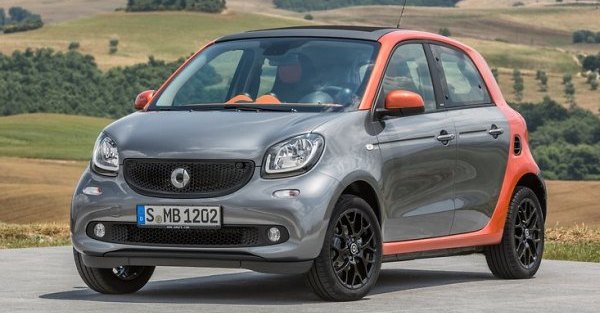
|
One thing so smart about
the new joint-venture with Renault is to give birth to both Fortwo and
Forfour on a common platform. You might remember the old Forfour was a
repackaged Mitsubisihi Colt built by the Japanese maker’s plant in
Holland. It was supposed to widen the market appeal of Smart, but
unfortunately the market quickly realized its relationship with
Mitsubishi and found its higher prices brought no benefits other than
image. Its sales flopped and, after only 2 years, Mercedes axed the
car. The new Forfour is unlikely to repeat this history as its platform
is designed primarily by Mercedes, although it is assembled by
Renault’s plant in Slovenia together with Twingo (the Fortwo's
production remains at Smart's own plant in Hambach, France). Besides,
working with a partner like Renault should guarantee higher production
volume than Mitsubishi, hence lower production cost.
From pictures it is already clear that the Forfour II is the twins
sister of Twingo III. They share 70 percent of all components,
including the whole steel monocoque. Different body panels, bumpers,
lights and tailgates are attached to distinguish them. On the Smart,
the roof rails and rear quarter panels are deliberately painted in
different color in Smart fashion. The whole front end is shared with
Fortwo, as are the taillights, to give family resemblance and save
further costs. In fact, you can see the new Forfour as a stretched,
4-seat version of the Fortwo. Its body length and wheelbase are 800 mm
and 621 mm longer than the Fortwo’s respectively. This allows it to
accommodate a pair of proper rear
seats.
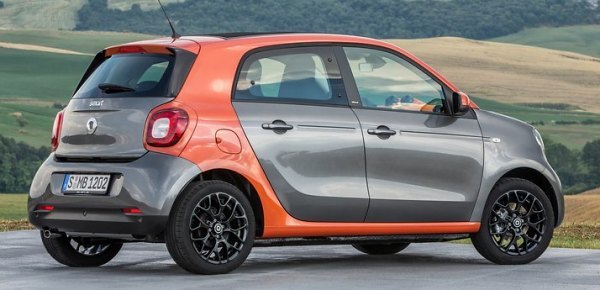
|
For a car slightly shorter than Fiat 500, those rear seats
are quite generous. Provided the passengers are shorter than 6 feet,
they will find the rear seats tolerable for short trips. Not so
welcomed is the lack of winding rear windows. As in Twingo, it uses
cheaper pop-out windows instead. On the plus side, this saves the need
of an extra pillar and rear quarter window each side thus cleans up the
styling. The front cabin shares the same dashboard, door panels,
equipment and simply everything with Fortwo. As expected, the rear
bench can fold flat to expand luggage space, and the cushions can be
flipped into the floor to store taller items. Meanwhile, the front
passenger seat may fold to take longer items. This is a small yet
flexible package.
Like Twingo, the Forfour is extremely maneuverable in city thanks to an
ultra-tight turning circle. Its driving dynamics is close to Renault,
which is agile at urban speed but understeers excessively when you push
it harder. Its wider rear tires and mandatory ESP guarantee you have no
chance to push its tail wide, thus there is not much thrills or
engagement for keen drivers to enjoy. You might even say it is a waste
of the RR layout. The ride quality is inseparable with Renault, too,
but definitely better than Fortwo, thanks to the longer wheelbase.
High-speed refinement is also better. The Forfour employs more sound
deadening materials than Twingo, which is useful to calm down its 0.9
TCe engine at higher rev. Both engines are shared with its sisters,
thus performance is average.
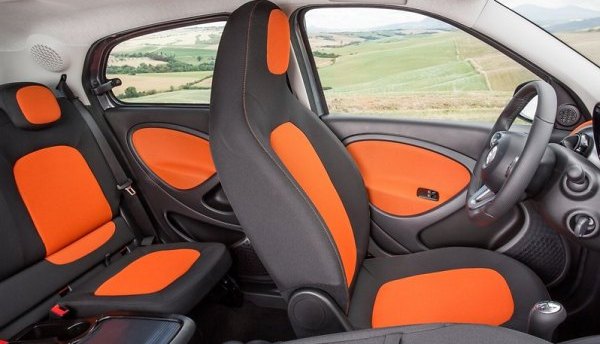
|
The problem for the 4-seat Smart is again high prices versus
what it offers. Rivals like Volkswagen Up, Fiat Panda and Hyundai i10
are a lot cheaper, while the cute Fiat 500 remains an image leader.
Meanwhile, Renault Twingo offers the same car at keener prices yet
looks more tastefully styled. The case of Forfour is not very
convincing.
|
Verdict:    |
Published
on 18
Jul 2016
|
All rights reserved.
|
|
Fortwo / Forfour Brabus
|
|
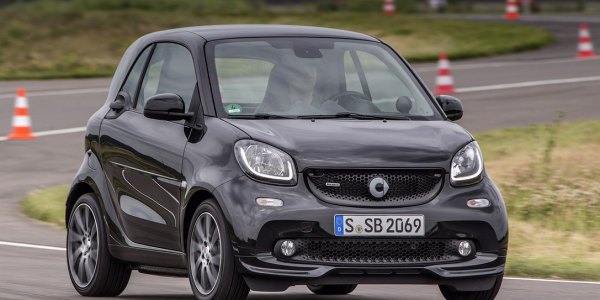
|
Brabus is known for tuning
large Mercedes-Benz but it also modifies the tiny Smart. In 2002, it
formed a 50/50 joint venture with Smart which allowed its name to
appear on the official line-up of Smart. The effect is not unlike John
Cooper Works to Mini, just in a smaller scale. The latest Brabus
versions of Fortwo and Forfour are powered by a higher tuned 0.9-liter
3-cylinder turbo engine. Its output is lifted by 19 horsepower and 25
pound-foot of torque to 109 hp and 125 lbft respectively. Smart said
this is achieved by increasing fuel injection pressure and tuned intake
and exhaust, but I would be surprised if turbo boost was unaltered. I
suspect the modification was done by Renault instead of Brabus, because
the engine is a Renault unit, and the same tune will appear on its
Twingo GT, which is the twins sister of Forfour.
Frankly, even with the power boost this is still hardly a hot hatch –
perhaps not even a “warm hatch”. A Suzuki Swift Sport has 134 hp on tap
and even the least powerful Abarth 595 offers 145 hp. 109 horsepower is
nothing these days, even though the Fortwo weighs just over 900 kg. The
Forfour carries another 100 kg, no wonder it takes almost 10 seconds to
go from rest to 60 mph. However, worse still is the way the little
engine delivers its power. It shows considerable turbo lag below 2000
rpm, something the 3-pot turbos of Ford and Opel managed to minimize.
It doesn’t rev high either, so the power band is rather narrow, and you
need to keep it on boil at the mid-range. Throttle response is pretty
slow. Step on the gas and wait for a couple of seconds, it wakes up and
surges forward. Such a non-linear power delivery is all too
old-fashioned. Even the tuned exhaust is not especially engaging.
Renault should have directed more money from its Formula One engine
program back to the production side.
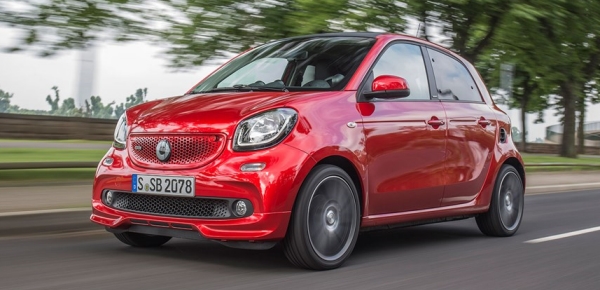
|
The 6-speed twin-clutch gearbox used by the Brabus models
has received shorter ratios and revised programming for 40 percent
faster shifts. It is better, but still not fast enough by the standard
of DCT. Moreover, the gearshift feels jerky in start-stop traffic,
something in which the city car is likely to spend more time.
Both cars get larger wheels, wider tires and suspension that is 20
percent stiffer and 10 mm lower. The front anti-roll bar is thicker.
Body roll is certainly reduced and grip is more abundant, but you won’t
confuse it with a hot hatch either. All you can say is it feels more
planted in fast corner than the regular car. However, its cornering
limit remains lower than expected. Its combination of narrower front
tires (vs the rear) and stiffer front anti-roll bar continues to result
in strong understeer when it approaches the limit. The variable-ratio
electric power steering has been retuned, but apart from a stronger
self-centering force you can’t feel any improvement. Feel from the helm
is still very limited. In town, the Smart duo is unusually agile thanks
to short wheelbase and small turning circle, especially Fortwo. At
faster pace where the suspension is loaded, its agility is replaced
with reluctance and delay. Now you think: maybe its rear-engined
chassis is not that good. Porsche had not sorted out the 911 until 993
introduced multi-link suspension. Before that, all 911s were edgy to
drive. The Smart has to be safe in any cases, so its chassis tuning is
dialed to the opposite side of Porsche. Not even the Brabus version
could do very much to alter its fundamental problems.
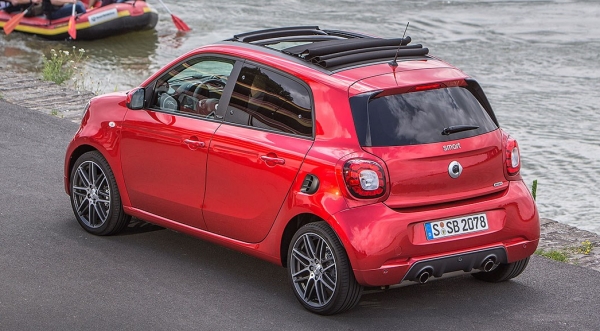
|
While
they are not much fun to drive, they are not too difficult to live
with. The stiffer suspension does not rob ride comfort much. Though not
great, it is perfectly acceptable on Forfour. The ultra-short wheelbase
of Fortwo demands more mercy from its occupants, but the same can be
said to the standard car.
With a poor engine, lukewarm performance and a mediocre chassis, it is
hard to understand who would buy the Brabus duo. They are expensive,
too, costing more to buy than the cheapest Abarth 595 and almost a
match to our hot hatch king, Ford Fiesta ST. Crazy.
|
Verdict:   |
|
|
|
|
|
|
|
|
|
|
Fortwo 1.0
|
2014
|
| Rear-engined,
RWD |
| Steel monocoque |
Steel + plastic
|
| 2695 / 1663 / 1555 mm |
| 1873 mm |
Inline-3
|
| 999 cc |
DOHC 12 valves, VVT
|
| - |
| - |
71 hp
|
67 lbft
|
5-speed manual
|
F: strut
R: de-Dion axle
|
| - |
F: 165/65R15
R: 185/60R15
|
805 kg
|
| 94 mph (c) |
14 (est)
|
| - |
|
Fortwo turbo
|
2014
|
| Rear-engined,
RWD |
| Steel monocoque |
| Steel + plastic |
| 2695 / 1663 / 1555 mm |
| 1873 mm |
Inline-3
|
| 898 cc |
DOHC 12 valves, VVT
|
| Turbo |
| - |
90 hp
|
100 lbft
|
5-speed manual
|
F: strut
R: de-Dion axle
|
| - |
F: 165/65R15
R: 185/60R15
|
825 kg
|
| 96 mph (c) |
10.1 (c)
|
| - |
|
Fortwo Brabus
|
2016
|
| Rear-engined,
RWD |
| Steel monocoque |
| Steel + plastic |
| 2740 / 1663 / 1543 mm |
| 1873 mm |
Inline-3
|
| 898 cc |
DOHC 12 valves, VVT
|
| Turbo |
| - |
109 hp
|
125 lbft
|
6-speed twin-clutch
|
F: strut
R: de-Dion axle
|
| - |
F: 185/50R16
R: 205/40R17
|
920 kg
|
| 103 mph (c) |
8.9 (c)
|
| - |
|
|
|
|
|
Performance
tested by: -
|
|
|
|
|
|
|
Forfour 1.0
|
2014
|
| Rear-engined,
RWD |
| Steel monocoque |
| Steel + plastic |
| 3495 / 1665 / 1554 mm |
| 2494 mm |
Inline-3
|
| 999 cc |
DOHC 12 valves, VVT
|
| - |
| - |
71 hp
|
67 lbft
|
5-speed manual
|
F: strut
R: de-Dion axle
|
| - |
F: 165/65R15
R: 185/60R15
|
900 kg
|
| 94 mph (c) |
16 (est)
|
| - |
|
Forfour turbo
|
2014
|
| Rear-engined,
RWD |
| Steel monocoque |
| Steel + plastic |
| 3495 / 1665 / 1554 mm |
| 2494 mm |
Inline-3
|
| 898 cc |
DOHC 12 valves, VVT
|
| Turbo |
| - |
90 hp
|
100 lbft
|
5-speed manual
|
F: strut
R: de-Dion axle
|
| - |
F: 165/65R15
R: 185/60R15
|
920 kg
|
| 103 mph (limited) |
10.5 (c)
|
| - |
|
Forfour Brabus
|
2016
|
| Rear-engined,
RWD |
| Steel monocoque |
| Steel + plastic |
| 3525 / 1665 / 1543 mm |
| 2494 mm |
Inline-3
|
| 898 cc |
DOHC 12 valves, VVT
|
| Turbo |
| - |
109 hp
|
125 lbft
|
6-speed twin-clutch
|
F: strut
R: de-Dion axle
|
| - |
F: 185/45R17
R: 205/40R17
|
1020 kg
|
| 112 mph (c) |
9.9 (c)
|
| - |
|
|
|
|
|
| Performance
tested by: - |
|
|
|
|
|
|
|
|
|
|
Fortwo

|
|
Fortwo Brabus
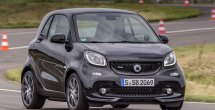
|
|
|
Copyright©
1997-2016
by Mark Wan @ AutoZine
|
|